Apple introduces new $329 iPad to win back the education market
Apple Inc. (AAPL) on Tuesday announced its latest iPads with the intention of taking back the student market, which Google (GOOG, GOOGL) has been dominating with its low-cost Chromebooks. The tech giant’s latest slate, the new $329 iPad 9.7-inch, is an update to Apple’s base iPad, which was released in March 2017 and also cost $329.
Apple says it will sell the iPad for $299 for students and schools as it does with the current generation iPad.
Available for pre-order starting today, the slate looks similar to the existing iPad, but includes support for the Apple Pencil stylus, something that was previously only available with the company’s more expensive iPad Pro models. Inside, the iPad gets a more powerful A10 Fusion chip, which is the same processor found in the iPad Pro.

Taking on the Chromebook
Of course, Apple couldn’t help but take a shot at Google’s Chromebooks, saying that the A10 chip makes the iPad more powerful than virtually all Chromebooks on the market.
Apple also touted the iPad’s augmented reality capabilities in the classroom, something that Chromebooks can’t quite handle. In a demo, Apple showed apps that allow students to virtually dissect frogs and experience famous works of art up close and personal.

Apple’s Vice President of Product Marketing Greg Joswiak went so far as the claim that the new iPad is the greatest device ever created for students in the classroom. That’s a big hint at how much Apple wants to take the market back from Google’s Chromebooks.
In addition to its new iPad, Apple has introduced updated versions of its iWork apps. The new versions of Pages, Numbers and Keynote will now support the Apple Pencil, allowing you to draw directly on apps. They are also adding a smart annotation feature that lets you annotate documents directly in Pages.
Apple’s iPad business has seen a slight uptick in the past few quarters thanks to the company’s decision to sell the base iPad at a reduced price of $329 and the introduction of its iPad Pros. In the first quarter of 2018, Apple reported selling 13.2 million iPad units, which was up 1%. It’s not an enormous increase, but it’s far better than the years of declining sales the company previously saw in the category.
The fight for the classroom
But Apple has been losing market share in the coveted U.S. education space to Google and its low-cost, internet-connected Chromebooks. The devices, which are designed specifically for running online apps like Google’s Chrome browser and Google Docs and Drive, and more recently Android apps, have quickly become the go-to technology tools for school districts across the country.
According to industry analysis group Futuresource Consulting, Google’s Chromebooks captured as much as 60% of the education market in the third quarter of 2017. Microsoft’s (MSFT) Windows held 22% of the market, while Apple’s MacOS and iOS controlled roughly 17%.
In 2017, Microsoft launched its own laptop geared toward students, dubbed the Surface Laptop, along with a special version of Windows 10 built for the classroom called Windows 10 S, which only allowed for the installation of apps through the Microsoft-curated Windows Store. The company has since changed Windows 10 S to a Windows 10 mode rather than a separate version of the operating system.

The Surface Laptop, however, starts at $699, while Chromebooks are sold for as little as $179.
Apple, meanwhile, currently offers its MacBook Air for $999, which is out of reach for many school districts and students. The current-generation iPad, on the other hand, starts at $329, which is far more affordable.
Beyond taking a larger share of the education technology market, which research firm Frost & Sullivan estimates generated $17.7 billion in revenue in 2017 and will reach $40.9 billion by 2022, Apple’s decision to focus on the space is simple marketing. If you get more students and teachers using your products, you’re helping to build loyalty with new customers.

Of course, it’s not as if Apple hasn’t been a part of the education market for decades already. I remember playing “Oregon Trail” on the Macintosh computers in my elementary school computer lab in the 1990s. Over time, though, Macintosh machines fell out of favor with school districts and more and more began using Windows-based computers. Apple saw an uptick in the education market when its iPads came out, but Chromebooks have ruled the roost as of late.
Apple’s hope is that it can turn the tide and take over the industry once more.
More from Dan:
Facebook CEO Mark Zuckerberg breaks his silence about data leak
Facebook users don’t care about its myriad scandals
Email Daniel Howley at dhowley@yahoo-inc.com; follow him on Twitter at @DanielHowley.Follow Yahoo Finance on Facebook, Twitter, Instagram, and LinkedIn

 Yahoo Finance
Yahoo Finance 
